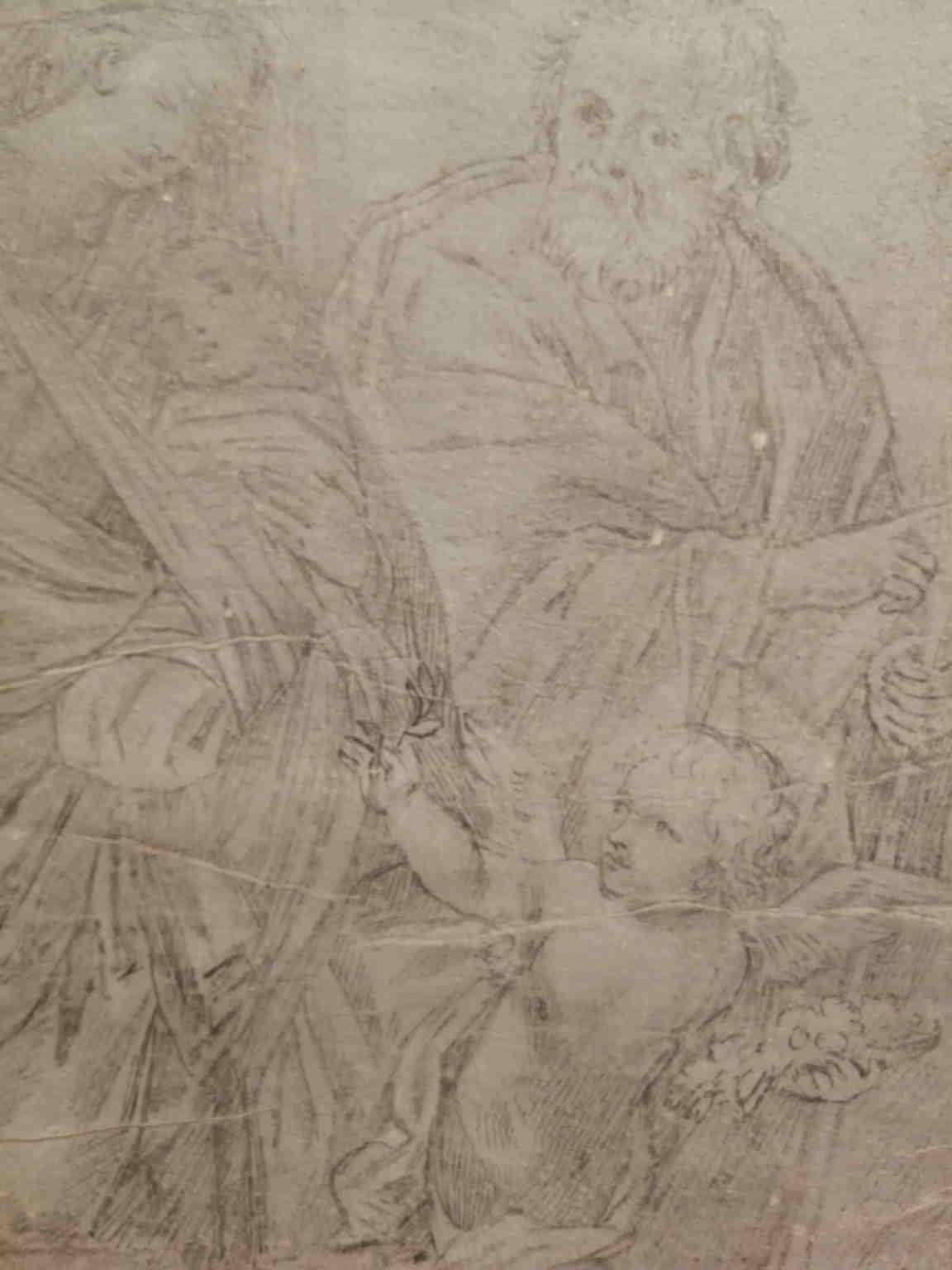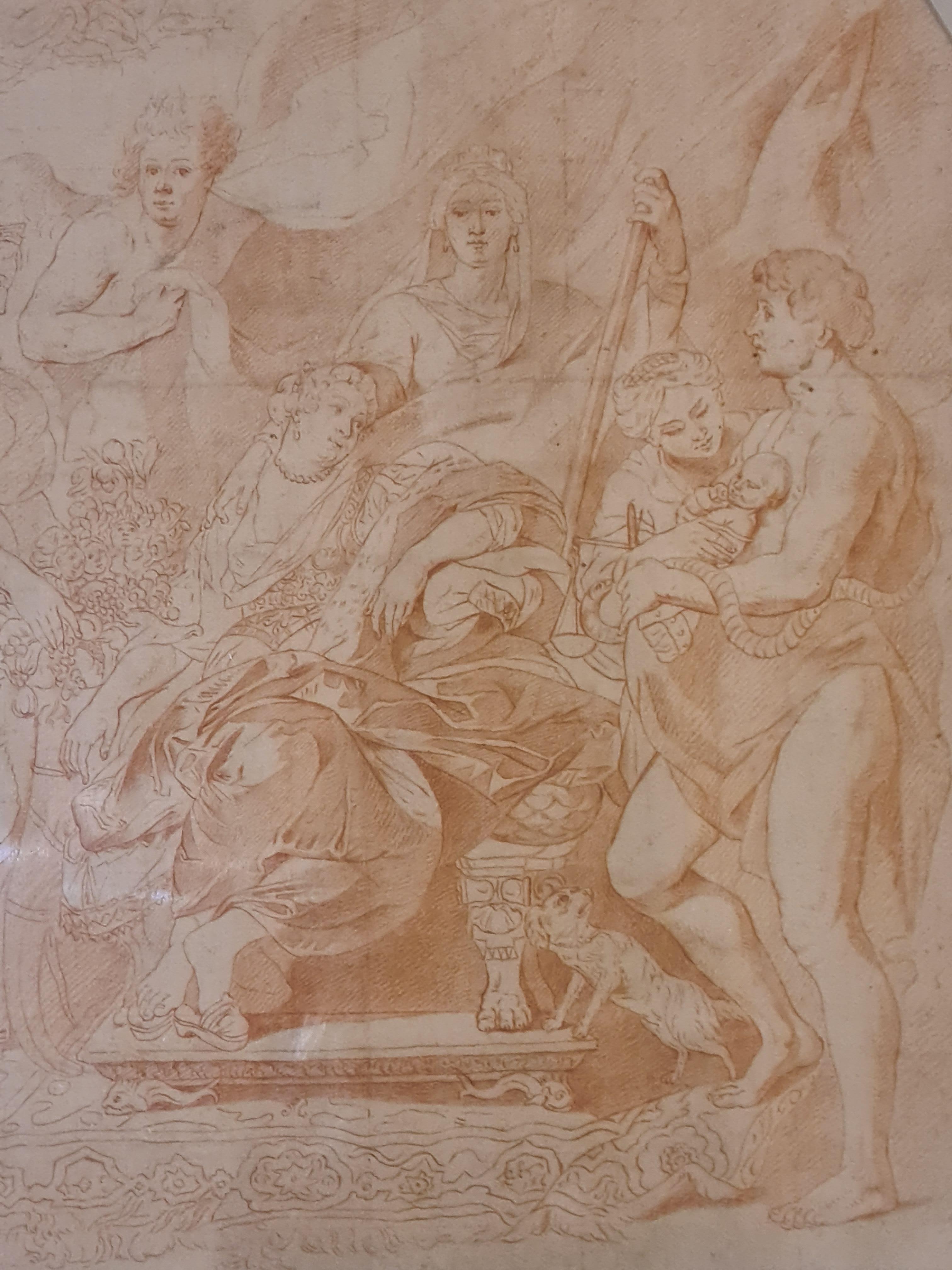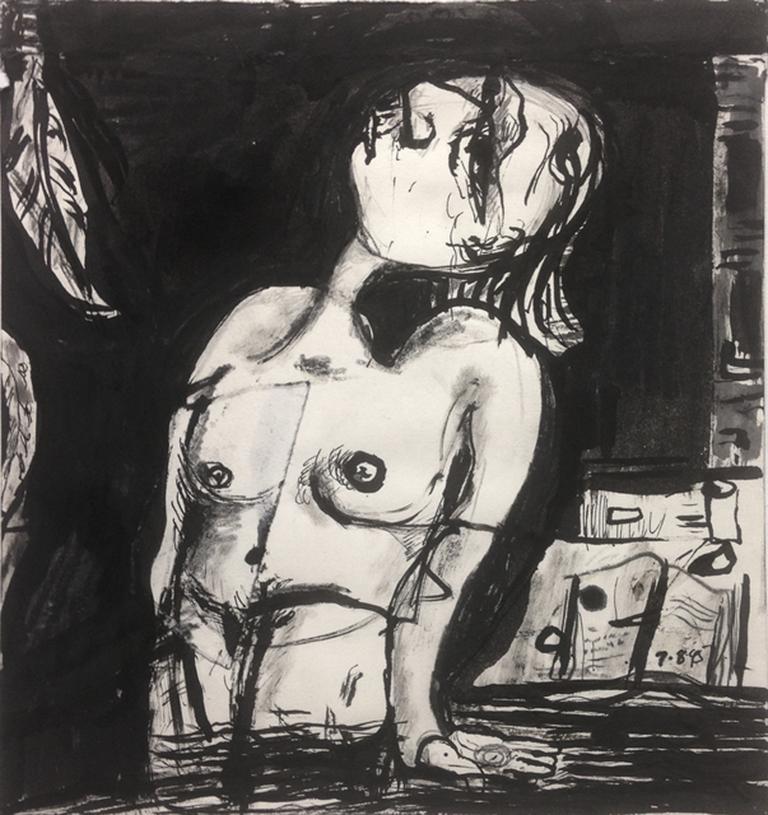Items Similar to The Rape of the Sabine Woman, ink and pencil. After Nicolas Poussin
Want more images or videos?
Request additional images or videos from the seller
1 of 10
The Rape of the Sabine Woman, ink and pencil. After Nicolas Poussin
About the Item
Poussin’s subject is the abduction of the Sabine women. Historically, this subject was known as The Rape of the Sabines (rape being derived from the latin raptio – a term used to describe abduction and/or enslavement). This story is from classical history; there are six drawings and two paintings by Poussin on the theme. The legend of the Sabine Women is connected to the early history of Rome. Romulus, the founder of the city (shown on the left-hand side of this drawing), wanted to make sure the city would grow and flourish and to do this he needed to grow the population. He invited communities who lived nearby to the city under the false pretence of celebrating a festival. The Sabines arrived with their families and the young men of Rome attacked them and abducted many of the Sabine Women.
It was a popular subject among patrons and artists during the Renaissance and Baroque periods. In the 17th century, when Poussin was alive (corresponding with the Baroque period) artists tended towards dramatic renderings of the story, with soldiers often on horseback gathering up protesting women.
Poussin’s style was influenced by Raphael and by classical antiquity.
Focus in on the central group of figures in the busy foreground scene. Note that there is one very distinct item of costume/clothing: the unmistakable curvilinear crest of the helmet of the Praetorian Guard (a high-ranking Roman Soldier).
Another striking feature of this drawing is that the artist use of brown wash to distinguish light from shade and the volume of human form against void.
- Dimensions:Height: 17.72 in (45 cm)Width: 23.63 in (60 cm)Depth: 0.79 in (2 cm)
- Medium:
- Movement & Style:
- After:(Circle of) Nicolas Poussin (1594 - 1661, French)
- Period:Early 17th Century
- Condition:
- Gallery Location:Brooklyn, NY
- Reference Number:1stDibs: LU159928591892
About the Seller
5.0
Vetted Seller
These experienced sellers undergo a comprehensive evaluation by our team of in-house experts.
Established in 2007
1stDibs seller since 2021
32 sales on 1stDibs
- ShippingRetrieving quote...Ships From: Brooklyn, NY
- Return PolicyA return for this item may be initiated within 2 days of delivery.
More From This SellerView All
- Post-Impressionist drawing of a man drinkingLocated in Brooklyn, NYThe passepartout contains the following legend 'Jean-François Raffaëlli - Paris 1889 - E. Universelle - 1885'.Category
Late 19th Century Post-Impressionist Figurative Drawings and Watercolors
MaterialsColor Pencil, Paper
- Reading Madonna drawing. Red chalk on paper.By Francesco FernandiLocated in Brooklyn, NYInscribed: front, brown ink, bottom left, F. Imperiali pinx…; bottom right, R. Rol..(?). Back, brown ink, top left, Roma, Gune(?) 1742 / F. Impeririali ping…;[illegible] R. deline..(...Category
Mid-18th Century Figurative Drawings and Watercolors
MaterialsHandmade Paper, Chalk
- Sanguine drawing "Shepherdess on a Donkey" by Nicolaes BerchemBy Nicolaes BerchemLocated in Brooklyn, NYProvenance: Mercedes von Dietrichtein, Buenos Aires. Alexander von Dietrichstein. By descendants Morritz von Diestrichstein. Nicolaes Pieterszoon Berchem (1 October 1620 – 18 February 1683) was a highly esteemed and prolific Dutch Golden Age painter of pastoral landscapes, populated with mythological or biblical figures, but also of a number of allegories and genre pieces. He was a member of the second generation of "Dutch Italianate landscape" painters. These were artists who travelled to Italy, or aspired to, in order to soak up the romanticism of the country, bringing home sketchbooks full of drawings of classical ruins and pastoral imagery. His paintings, of which he produced an immense number, (Hofstede de Groot claimed around 850, although many are misattributed), were in great demand, as were his 80 etchings and 500 drawings. His landscapes, painted in the Italian style of idealized rural scenes, with hills, mountains, cliffs and trees in a golden dawn...Category
17th Century Dutch School Figurative Drawings and Watercolors
MaterialsPaper, Chalk
- Holy Family, by the bolgonese master.By Giuseppe Maria Crespi, Lo SpagnuoloLocated in Brooklyn, NYThis exquisite painting, resembling a precious jewel, serves as an exceptional illustration of the devotional cabinet paintings created by Giuseppe Maria Crespi, a highly original Bolognese artist during the late 17th and early 18th centuries. Crespi's distinctiveness extended beyond his unique style and technique to the subjects he chose to portray. While his portraits and genre paintings often displayed a light-hearted and even irreverent tone, his treatment of religious themes resonated with deep emotion, even in its most inventive forms. This recently uncovered work by Crespi is a typical representation, invoking the tender connection between mother and child, and the Child's destiny, all within a compact and intimate format. Executed on a small scale, the painting showcases Crespi's remarkable sensitivity and mastery of paint, especially evident in the expressive brushwork of the drapery. The restrained and focused composition of the Holy Family allows for contemplation of the figures. Mary cradles the Christ child gently, seemingly presenting him to the viewer, her gaze knowing as the infant holds a diminutive cross, symbolizing his future crucifixion. Joseph appears in the background, emerging from the left side of the frame, gazing upward with folded hands in prayer. Individual motifs from this painting reappear in other works by Crespi, suggesting a synthesis of familiar elements into a vibrant composition. The artist's revisitation of designs throughout his career is evident, and this painting on copper likely belongs to a later period, reflecting stylistic ties to other works and Crespi's increased production of smaller devotional pieces. Distinguished by its cool palette, bold coloration, and the expressive force of the artist's hand, this Holy Family painting...Category
Early 1700s Baroque Figurative Paintings
MaterialsCopper
- Saint Michael the Archangel, Sevillan schoolLocated in Brooklyn, NYAn engraving by Jerónimo Wierix after Marten de Vos's Saint Michael the Archangel (Iglesia de San Miguel, Córdoba) may have been a source f...Category
17th Century Baroque Figurative Paintings
MaterialsOil, Canvas
- Tulips, lilys, hyacinths and dahlias in a bronze vase, oil on canvas.By Andrea ScacciatiLocated in Brooklyn, NYTogether with his son Pietro Neri, Andrea Scacciati was active at the Medici court and is well known for his still lifes with flowers. His works display both Roman and northern influ...Category
Early 18th Century Baroque Still-life Paintings
MaterialsOil, Canvas
You May Also Like
- Francesco Furini Sanguine Drawing before 1642Located in Florence, ITPreparatory Drawing (sanguine on paper, 42 x 28 cm) by Francesco Furini for the making of the Saint Sebastian, ordered by the prince Lorenzo de' Medic...Category
1640s Baroque Nude Drawings and Watercolors
MaterialsColor Pencil, Paper
- After Guido Reni Religious Figurative Drawing 19 century pencil laid paperBy (After) Guido ReniLocated in Florence, ITThe drawing, pencil on laid paper 29 x 27 cm, represents a moment of rest during the Flight to Egypt. It's a study on an etching ispired by a Guido Reni's painting, made by him durin...Category
Early 19th Century Baroque Figurative Drawings and Watercolors
MaterialsPencil, Laid Paper
- Heinrich Adam Elias Borny (1742 - 1778) Soldier - 18thC Ink Drawing - GermanyLocated in Meinisberg, CHHeinrich Adam Elias Borny (German, 1742-1778) • Late baroque Ink and pen drawing on laid paper (no watermark) • Sheet, ca. 29.4 x 22.7 cm • Imag...Category
1760s Baroque Figurative Drawings and Watercolors
MaterialsInk, Laid Paper
- Orpheus and the Animals, A Study after an Ancient Bas-ReliefLocated in New York, NYInscribed “55” and “218” in the lower right Watermark: Heawood 1351 Laid down on historic Cassiano Del Pozzo mount (Mount Type A, 531 x 402 mm) Provenance: Commissioned by Cassiano dal Pozzo (1588–1637) for his Museo Cartaceo (Paper Museum) and kept in the library of his palazzo, via dei Chiavari, Rome Transferred with the entire dal Pozzo collection by fidecommesso to his younger brother, Carlo Antonio dal Pozzo (1606–1689); by descent to his second son: Gabriele dal Pozzo (d. 1695); by descent to his wife: Anna Teresa Benzoni and after her remarriage in 1697, the Marchesa Lancellotti de’ Ginnetti (d. 1736); by descent to their son: Cosimo Antonio dal Pozzo (d. 1740); by whom sold with the Dal Pozzo library in 1703 to: Pope Clement XI for the Vatican Library; by whom transferred as part of the Museo Cartaceo in January 1714 to his nephew: Cardinal Alessandro Albani (1692–1779), Palazzo ‘alle Quattro Fontane’ in Rome; by whom sold in 1762 to: James Adam, agent for the British Royal Librarian Richard Dalton (1715–1791) King George III of England, Buckingham House Among the sheets of the ‘Museo Cartaceo’ appropriated by Richard Dalton during a reorganization of the drawings, circa 1786-1788; his estate sale, Greenwood’s, London, 11-19 May 1791; where acquired by: John MacGowan...Category
16th Century Baroque Figurative Drawings and Watercolors
MaterialsPaper, Ink, Pen
- 18th Century Sanguine Drawing, La Naissance de Louis XIII, After Rubens.Located in Cotignac, FR18th Century French Sanguine drawing, possibly a preparatory sketch for the painting by Nattier after the painting by Rubens. Presented in shaped 'marie-louise' mount in plain gold wood frame with collection label. The subject is the Queen Marie de' Medici seated on a grand throne, the baby is in the arms of Health while Justice looks over him. Fecundity brings a cornucopia of fruit with the heads of the other children the Queen will bear. The Sun rides his chariot across the sky to indicate that Louis XIII was born in the morning and the calm figure of France surveys the whole scene. An engraving exists (see the Wellcome Collection) of this same image: 'The birth of King Louis XIII', after the engraving by B. Audran the younger after the painting by Jean-Marc Nattier after the oil painting of Peter Paul Rubens in the Louvre 'La Naissance du Dauphin (future Louis XIII) à Fontainebleau, le 27 septembre 1601'. Jean-Marc Nattier (17 March 1685 – 7 November 1766) was a French painter. He was born in Paris, the second son of Marc Nattier (1642–1705), a portrait painter, and of Marie Courtois (1655–1703), a miniaturist. He is noted for his portraits of the ladies of King Louis XV's court in classical mythological attire. He received his first instruction from his father, and from his uncle, the history painter Jean Jouvenet (1644–1717). He enrolled in the Royal Academy in 1703 and applied himself to copying pictures in the Luxembourg Palace, making a series of drawings of the Marie de Médici painting...Category
18th Century Baroque Figurative Drawings and Watercolors
MaterialsInk, Chalk, Paper, Clay
- "Wading Woman", drawing, ink, portraitLocated in Toronto, OntarioInk, litho crayon & collage on paperCategory
21st Century and Contemporary Mannerist Figurative Drawings and Watercolors
MaterialsInk, Paper, Crayon
Recently Viewed
View AllMore Ways To Browse
Brown Wash
The Protest
Circle Of Women
Roman Pencil
Pencil And Wash
Raphael And The Antique
Figures Of Men And Women
Drawing After Raphael
Roman Soldier
17th Century Costume
Roman Historical Paintings
The Rape Of
Antique Womens Clothing
Soldier Helmet
Roman Baroque Painting
Abduction Of
Roman Soldier Art
Rape Painting





